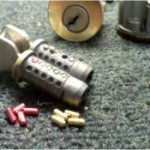Not all Key Copies are Created Equal


How key copies work. There are a few different ways to make a copy of a key. In the old days they would put a new uncut key and a cut key in a vice pressing them toegher. The cut key would be smoked with a flame to add black soot to the key pattern. A locksmith would take a file and start filing down the new key until the soot on the old key wiped away. That would tell the locksmith to stop filing there. When all the soot was gone from the original key, the duplicate should work.
There are a few problems with that. as you can guess, there is a chance you can file away some of the material from the original key and render it inoperative.
The more modern key duplicators trace the old key on one side, and use a cutting wheel to cut the same pattern on the other side. cutting several keys (like a master laundry room key for an apartment complex of 400) means you are causing the same problem, where the tracer is scrapping away marital away from the master copy like the older locksmith with the file.
The most modern key machines now use a laser eye to decode the original key, eliminating this problem and and can be set to either cut a near exact copy or a a copy cut to factory specs (code key), because the manufacturers of the machines know the master copies are often worn down a bit from use.
A locksmith can also “read” your key, and cut a new code key using a manual code cutter.
These code keys are often called 1st keys because they are the first generation of keys that will be used to make duplicates.
Duplicators that trace the master key (or 1st key) make near perfect copies, but they are never perfect. Due to limitations on the equipment the copy will always be slightly off, either having more or less material than the original copy. That copy of a 1st key is called a 2nd key, or second generation key. a duplicator be able to go out 5 generations of copies. (copy of a copy of a copy of a copy of a 1st key) and still work the lock, if calibrated correctly, but using a copier to photo copy a copy of a copy, the quality fades over time and over generations.
The newest machines that scan your original key and make a factory cut 1st key are slower and more expensive than traditional modern key machines, so most locksmiths just duplicate the key using a standard semi-automatic duplicator. If this is the case, you can protect the information on your key by putting your best copy aside and using it only to make copies. This means you should always get a good 2nd generation key copy from your original when you realize your working key has become worn and is starting to give you trouble.
I hope this help.
Michael ~ All About Locks
Recent Comments